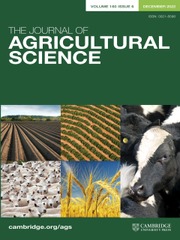Article contents
Liming as a factor in the amelioration of deteriorated tropical soils
Published online by Cambridge University Press: 27 March 2009
Extract
1. There exist in Trinidad large areas of deteriorated soils which have been under cultivation with a single short-term crop for generations. It has previously been established that these soils differ but little from those which still retain their fertility in their content of organic matter. By comparison with the latter, however, they are markedly acidic and so deficient in exchangeable calcium that a material improvement in their lime status appears to be a necessary preliminary to their amelioration. An examination has therefore been made of the means by which this may most successfully be accomplished.
2. Determinations of the contents of exchangeable calcium and the pH values of a series of liming experimental plots indicate that:
(a) Contrary to experience in England, finely ground limestone has proved a more efficient soil ameliorant than slaked lime.
(b) Single relatively large applications of lime fertilisers have given more immediate beneficial results than small annual dressings.
(c) The effect of liming appears to have been almost entirely restricted to the depth to which the soil is worked. This is doubtless due to the impermeability and lack of aeration which characterises heavy deteriorated soils.
3. A significant increase in crop yield was obtained only on those plots which were later shown to have been rendered neutral in reaction by liming, and on which the degree of saturation of the top 6 in. of soil has been raised to 80 per cent. This value is comparable with that of the fertile soils of Trinidad.
4. The experience of liming methods gained in Trinidad may be applicable to other areas of alluvial soils under cultivation in the tropics.
Information
- Type
- Research Article
- Information
- Copyright
- Copyright © Cambridge University Press 1929
References
REFERENCES
- 3
- Cited by

